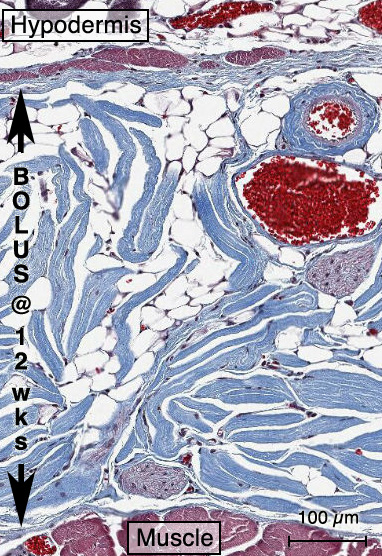Human ECM particles produced in vitro are injectable and support angiogenesis and adipogenesis in vivo
-
1
Cytograft Tissue Engineering, United States
-
2
Université de Bordeaux, U1026 BioTis, France
-
3
University of California, San Diego, Department of Bioengineering, Sanford Consortium for Regenerative Medicine, United States
-
4
CosmeticSurg, United States
Cell-synthesized ECM assembled by cultured cells has emerged as a promising biological scaffold for tissue engineering[1]. Tissue-engineered blood vessels built using rolled sheets of cell-assembled matrix (CAM) have shown unprecedented long-term patency in humans[2]. In this study, the CAM was mechanically processed into particles to produce an injectable form of the material suitable for many applications including aesthetic treatments. The goal of this study was to assess 1) the composition, 2) the injectability, 3) the stability, and 4) the host’s response to the CAM.
Adult human dermal fibroblasts were cultured to promote ECM production and assembly in sheets for 8 weeks as previously described[3]. Dried sheets were milled into particles that passed through a #60 sieve (250µm mesh) and sterilized by gamma irradiation. Particles composition was analyzed using mass spectroscopy, immunolabeling and biochemical testing. Particle suspensions in saline were injected subcutaneously in nude mice along with two commercially available dermal fillers: Juvéderm Ultra XC® (cross-linked hyaluronic acid-based product) and Radiesse® (hydroxyapatite-based product). Each of 12 animals received four injections (upper shoulders and thighs) and was sacrificed after 2, 4, 8 and 12 weeks (4 biopsies per material per time point).

Analysis of the ECM revealed that the particles contained numerous components including fibrillar and other collagens, elastic fiber components, fibrogenesis-associated and signaling components as well as glycosaminoglycans. The particle at 175 mg/ml produced a thick solution that could be injected through a 25 Ga needle. Subcutaneous injections were easily performed and, after diffusion of the excess injected fluids (≈24hrs), a palpable and localized bolus was observed. Histologically, the collagen rich particles were easily recognizable and generated a very mild inflammatory reaction with a generally thin fibrous layer around the injection site and only sparse immune cells. Rapid fibroblastic cell migration (2 weeks) was observed between the particles followed by progressive (2-12 week) perfusion by small blood vessels (also between particles). Adipocytes were also observed between particles within the injection bolus as early as 2 weeks but were more abundant as time went by. Cells did not appear to penetrate the particles and no signs of active degradation were observed.

On the other hand, Juvéderm® did not form a well-delineated injection bolus and did not elicit an active remodeling process. Radiesse generated a very significant inflammatory response throughout the study period with abundant immune cell migration, giant cell formation, thicker fibrous capsule formation and extensive angiogenesis.
These results clearly demonstrate the feasibility of injecting human CAM particles, at a clinically relevant concentration, using a clinically relevant system. Further more, these results support the idea that CAM is not targeted by the non-specific immune system. Finally, CAM particles supported both angiogenesis and adipogenesis. As a whole, these results illustrate the potential of this injectable material as a new tool for long-term tissue reconstruction and rejuvenation. While previous studies have shown great clinical successes using CAM-based tissue engineering[2], this is the first study to provide safety and remodeling data in a controlled setting.
Marissa Peck, David Gebhart, Sunny Virk, Casey Mount, and Heinz Scheuenstuhl; Sophia Suarez; Rebecca Braden; Jessica Ungerleider; Dr. Kent Osborn; ASEE/NSF Engineering Innovation Fellows Program; National Science Foundation Graduate Research Fellowship Program
References:
[1] Peck, M., Dusserre, N., McAllister, T.N. & L'Heureux, N. Tissue engineering by self-assembly. Materials Today 14, 218-224 (2011).
[2] McAllister, T.N., et al. Effectiveness of haemodialysis access with an autologous tissue-engineered vascular graft: a multicentre cohort study. Lancet 373, 1440-1446 (2009).
[3] L'Heureux, N., et al. Human tissue-engineered blood vessels for adult arterial revascularization. Nat. Med. 12, 361-365 (2006).
Keywords:
Extracellular Matrix,
Biocompatibility,
Tissue Regeneration,
acellullar matrix
Conference:
10th World Biomaterials Congress, Montréal, Canada, 17 May - 22 May, 2016.
Presentation Type:
Poster
Topic:
Regenerative medicine: biomaterials for control of tissue induction
Citation:
L'Heureux
N,
Young
AD,
Dusserre
N,
Sonnenberg
SB,
Johnson
TD,
Rodriguez
RL,
Mcallister
TN and
Christman
KL
(2016). Human ECM particles produced in vitro are injectable and support angiogenesis and adipogenesis in vivo.
Front. Bioeng. Biotechnol.
Conference Abstract:
10th World Biomaterials Congress.
doi: 10.3389/conf.FBIOE.2016.01.01758
Copyright:
The abstracts in this collection have not been subject to any Frontiers peer review or checks, and are not endorsed by Frontiers.
They are made available through the Frontiers publishing platform as a service to conference organizers and presenters.
The copyright in the individual abstracts is owned by the author of each abstract or his/her employer unless otherwise stated.
Each abstract, as well as the collection of abstracts, are published under a Creative Commons CC-BY 4.0 (attribution) licence (https://creativecommons.org/licenses/by/4.0/) and may thus be reproduced, translated, adapted and be the subject of derivative works provided the authors and Frontiers are attributed.
For Frontiers’ terms and conditions please see https://www.frontiersin.org/legal/terms-and-conditions.
Received:
27 Mar 2016;
Published Online:
30 Mar 2016.
*
Correspondence:
Dr. Nicolas L'Heureux, Cytograft Tissue Engineering, Novato, CA, United States, Email1
Dr. Adam D Young, University of California, San Diego, Department of Bioengineering, Sanford Consortium for Regenerative Medicine, La Jolla, CA, United States, adam.young08@gmail.com
Dr. Nathalie Dusserre, Cytograft Tissue Engineering, Novato, CA, United States, Nathduss@yahoo.com
Dr. Sonya B Sonnenberg, University of California, San Diego, Department of Bioengineering, Sanford Consortium for Regenerative Medicine, La Jolla, CA, United States, sseifnar@ucsd.edu
Dr. Todd D Johnson, University of California, San Diego, Department of Bioengineering, Sanford Consortium for Regenerative Medicine, La Jolla, CA, United States, nso@ucsd.edu
Dr. Ricardo L Rodriguez, CosmeticSurg, Baltimore, MD, United States, dr.rodriguez@me.com
Dr. Todd N Mcallister, Cytograft Tissue Engineering, Novato, CA, United States, Todd@cytograft.com
Dr. Karen L Christman, University of California, San Diego, Department of Bioengineering, Sanford Consortium for Regenerative Medicine, La Jolla, CA, United States, christman@eng.ucsd.edu